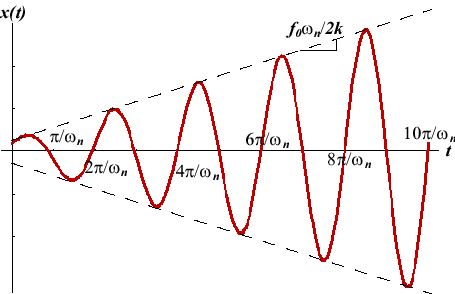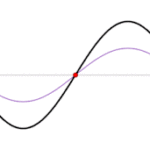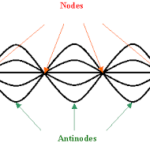Musical instruments and other objects are set into vibration at their natural frequency when a person hits, strikes, strums, plucks or somehow disturbs the object. For instance, a guitar string is strummed or plucked; a piano string is hit with a hammer when a pedal is played; and the tines of a tuning fork are hit with a rubber mallet. Whatever the case, a person or thing puts energy into the instrument by direct contact with it. This input of energy disturbs the particles and forces the object into vibrational motion – at its natural frequency.
If you were to take a guitar string and stretch it to a given length and a given tightness and have a friend pluck it, you would hear a noise; but the noise would not even be close in comparison to the loudness produced by an acoustic guitar. On the other hand, if the string is attached to the sound box of the guitar, the vibrating string is capable of forcing the sound box into vibrating at that same natural frequency. The sound box in turn forces air particles inside the box into vibrational motion at the same natural frequency as the string. The entire system (string, guitar, and enclosed air) begins vibrating and forces surrounding air particles into vibrational motion. The tendency of one object to force another adjoining or interconnectedobject into vibrational motion is referred to as a forced vibration. In the case of the guitar string mounted to the sound box, the fact that the surface area of the sound box is greater than the surface area of the string means that more surrounding air particles will be forced into vibration. This causes an increase in the amplitude and thus loudness of the sound.
 This same principle of a forced vibration is often demonstrated in a Physics classroom using a tuning fork. If the tuning fork is held in your hand and hit with a rubber mallet, a sound is produced as the tines of the tuning fork set surrounding air particles into vibrational motion. The sound produced by the tuning fork is barely audible to students in the back rows of the room. However, if the tuning fork is set upon the whiteboard panel or the glass panel of the overhead projector, the panel begins vibrating at the same natural frequency of the tuning fork. The tuning fork forces surrounding glass (or vinyl) particles into vibrational motion. The vibrating whiteboard or overhead projector panel in turn forces surrounding air particles into vibrational motion and the result is an increase in the amplitude and thus loudness of the sound. This principle of forced vibration explains why demonstration tuning forks are mounted on a sound box, why a commercial music box mechanism is mounted on a sounding board, why a guitar utilizes a sound box, and why a piano string is attached to a sounding board. A louder sound is always produced when an accompanying object of greater surface area is forced into vibration at the same natural frequency.
This same principle of a forced vibration is often demonstrated in a Physics classroom using a tuning fork. If the tuning fork is held in your hand and hit with a rubber mallet, a sound is produced as the tines of the tuning fork set surrounding air particles into vibrational motion. The sound produced by the tuning fork is barely audible to students in the back rows of the room. However, if the tuning fork is set upon the whiteboard panel or the glass panel of the overhead projector, the panel begins vibrating at the same natural frequency of the tuning fork. The tuning fork forces surrounding glass (or vinyl) particles into vibrational motion. The vibrating whiteboard or overhead projector panel in turn forces surrounding air particles into vibrational motion and the result is an increase in the amplitude and thus loudness of the sound. This principle of forced vibration explains why demonstration tuning forks are mounted on a sound box, why a commercial music box mechanism is mounted on a sounding board, why a guitar utilizes a sound box, and why a piano string is attached to a sounding board. A louder sound is always produced when an accompanying object of greater surface area is forced into vibration at the same natural frequency.
Resonance
Now consider a related situation that resembles another common Physics demonstration. Suppose that a tuning fork is mounted on a sound box and set upon the table; and suppose a second tuning fork/sound  box system having the same natural frequency (say 256 Hz) is placed on the table near the first system. Neither of the tuning forks is vibrating. Suppose the first tuning fork is struck with a rubber mallet and the tines begin vibrating at its natural frequency – 256 Hz. These vibrations set its sound box and the air inside the sound box vibrating at the same natural frequency of 256 Hz. Surrounding air particles are set into vibrational motion at the same natural frequency of 256 Hz and every student in the classroom hears the sound. Then the tines of the tuning fork are grabbed to prevent their vibration and remarkably the sound of 256 Hz is still being heard. Only now the sound is being produced by the second tuning fork – the one which wasn’t hit with the mallet. Amazing!! The demonstration is often repeated to assure that the same surprising results are observed. They are! What is happening?
box system having the same natural frequency (say 256 Hz) is placed on the table near the first system. Neither of the tuning forks is vibrating. Suppose the first tuning fork is struck with a rubber mallet and the tines begin vibrating at its natural frequency – 256 Hz. These vibrations set its sound box and the air inside the sound box vibrating at the same natural frequency of 256 Hz. Surrounding air particles are set into vibrational motion at the same natural frequency of 256 Hz and every student in the classroom hears the sound. Then the tines of the tuning fork are grabbed to prevent their vibration and remarkably the sound of 256 Hz is still being heard. Only now the sound is being produced by the second tuning fork – the one which wasn’t hit with the mallet. Amazing!! The demonstration is often repeated to assure that the same surprising results are observed. They are! What is happening?
In this demonstration, one tuning fork forces another tuning fork into vibrational motion at the same natural frequency. The two forks are connected by the surrounding air particles. As the air particles surrounding the first fork (and its connected sound box) begin vibrating, the pressure waves that it creates begin to impinge at a periodic and regular rate of 256 Hz upon the second tuning fork (and its connected sound box). The energy carried by this sound wave through the air is tuned to the frequency of the second tuning fork. Since the incoming sound waves share the same natural frequency as the second tuning fork, the tuning fork easily begins vibrating at its natural frequency. This is an example of resonance – when one object vibrating at the same natural frequency of a second object forces that second object into vibrational motion.
The result of resonance is always a large vibration. Regardless of the vibrating system, if resonance occurs, a large vibration results. This is often demonstrated in a Physics class with an odd-looking mechanical system resembling an inverted pendulum. The apparatus consists of three sets of two identical plastic bobs mounted on a very elastic metal pole, which are in turn mounted to a metal bar. Each metal pole and attached bob has a different length, thus giving it a different natural frequency of vibration. The bobs are often color-coded to distinguish between them; they are colored red, blue and green (a set of three colors that will be significant later in The Physics Classroom Tutorial). The red bobs are mounted on the longer poles and they have the lowest natural frequency of vibration. The blue bobs are mounted on the shorter poles and have the highest natural frequency of vibration. (Note the length-wavelength-frequency relationship that was discussed earlier.) When the red bob is disturbed, it begins vibrating at its natural frequency. This in turn forces the attached bar to vibrate at the same frequency; and this forces the other attached red bob into vibrating at the same natural frequency. This is resonance – one bob vibrating at a given frequency forcing a second object with the same natural frequency into vibrational motion. While the green and the blue bobs were disturbed by the vibrations transmitted through the metal bar, only the red bob would resonate. This is because the frequency of the first red bob is tuned to the frequency of the second red bob; they share the same natural frequency. The result is that the second red bob begins vibrating with a huge amplitude.
bobs mounted on a very elastic metal pole, which are in turn mounted to a metal bar. Each metal pole and attached bob has a different length, thus giving it a different natural frequency of vibration. The bobs are often color-coded to distinguish between them; they are colored red, blue and green (a set of three colors that will be significant later in The Physics Classroom Tutorial). The red bobs are mounted on the longer poles and they have the lowest natural frequency of vibration. The blue bobs are mounted on the shorter poles and have the highest natural frequency of vibration. (Note the length-wavelength-frequency relationship that was discussed earlier.) When the red bob is disturbed, it begins vibrating at its natural frequency. This in turn forces the attached bar to vibrate at the same frequency; and this forces the other attached red bob into vibrating at the same natural frequency. This is resonance – one bob vibrating at a given frequency forcing a second object with the same natural frequency into vibrational motion. While the green and the blue bobs were disturbed by the vibrations transmitted through the metal bar, only the red bob would resonate. This is because the frequency of the first red bob is tuned to the frequency of the second red bob; they share the same natural frequency. The result is that the second red bob begins vibrating with a huge amplitude.
 Another common classroom demonstration of resonance involves a plastic tube containing an air column. The length of the air column was adjusted by raising and lowering a reservoir of water (dyed red). The raising and lowering of the reservoir adjusts the height of water in the open-air tube, and thus adjusts the length of the air column inside the tube. As the length of the air column is decreased, the natural frequency of the air column is increased. (Again note the length-wavelength-frequency relationship that was discussed earlier.) While adjusting the height of the liquid in the tube, a vibrating tuning fork is held above the air column of the tube. When the natural frequency of the air column is tuned to the frequency of the vibrating tuning fork, resonance occurs and a loud sound results. Quite amazingly, the vibrating tuning fork forces air particles within the air column into vibrational motion. Once more in this resonance situation, the tuning fork and the air column share the same vibrational frequency.
Another common classroom demonstration of resonance involves a plastic tube containing an air column. The length of the air column was adjusted by raising and lowering a reservoir of water (dyed red). The raising and lowering of the reservoir adjusts the height of water in the open-air tube, and thus adjusts the length of the air column inside the tube. As the length of the air column is decreased, the natural frequency of the air column is increased. (Again note the length-wavelength-frequency relationship that was discussed earlier.) While adjusting the height of the liquid in the tube, a vibrating tuning fork is held above the air column of the tube. When the natural frequency of the air column is tuned to the frequency of the vibrating tuning fork, resonance occurs and a loud sound results. Quite amazingly, the vibrating tuning fork forces air particles within the air column into vibrational motion. Once more in this resonance situation, the tuning fork and the air column share the same vibrational frequency.
In conclusion, resonance occurs when two interconnected objects share the same vibrational frequency. When one of the objects is vibrating, it forces the second object into vibrational motion. The result is a large vibration. And if a sound wave within the audible range of human hearing is produced, a loud sound is heard.


